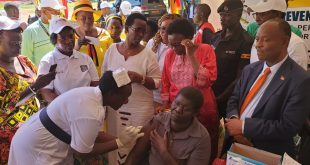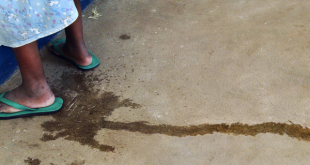Thursday, 27 October 2022

By Timothy Eodu-Karamoja
Leaders from Karamoja have plauded the permanent secretary, Dr. Diana Atwine and the Ministry of Health for it’s response towards eliminating Malaria from the region.
The leaders who joined the ministry officials during the launch of the Seasonal Malaria Chemoprevention said Malaria has greatly affected their people over time yet most of them remain vulnerable with little or no access to better health care.
Representing the local council LC5 chairperson, David Koriang the Moroto LC5 said most children and mothers in the manyattas have now been relieved from moving long distances to health centers.

He said due to higher demand for anti-malerial treatment in the region, health facilities usually run out of supplies within few weeks leaving more patients and as such leading to severe malaria in communities.
Koriang said the ministry’s approach of using the Village Health Teams (VHTs) to support people in villages has saved a lot of lives already.
According to Hon. Faith Nakut the Napak district woman MP, the project has come at such a time when the region was healing from insecurity and hunger which both affected access to health care in one way or the other.
She pleaded with the Permanent Secretary Dr. Diana Atwine and the Ministry of Health to consider putting up at least any health care service in two Sub Counties of Ngoleriet and since people there have to move longer distances to access health services.
Betty Louke Chelain the woman MP of Amudat said there is need to build capacity of the VHTs and also facilitate them so that they can perform better in the malaria prevention program in the region.
Dr Musa Odongo – Malaria Technical specialist SMC Malaria Consortium says over 90% of targeted children were protected in intervention districts. In the intervention area 90% never experienced a malaria episode compared with 15% in the control area.
Hon. Anifa Kawooya Bangirana, State Minister of Health in charge General Duties said they have seen that providing SPAQ to children through this programme amounts to a ‘best buy’ in government’s efforts to bring down the burden of malaria in communities.
She said that it is exciting to be able to scale up the SMC programme to cover eight districts of Karamoja, meaning the ministry is now able to protect around 300,000 children every month from malaria.
According to the 2021 World Malaria Report, Uganda was the third and fifth highest contributor of global malaria cases and deaths respectively.
Malaria prevalence is highly heterogeneous in Uganda; ranging from 1% in southwest and central regions to 34% in the northeast Karamoja region.
For over two decades, the Karamoja region has registered the highest malaria incidence in Uganda ranging between 250 and 450 per 1000 people as compared to the national incidence of 30 per 1000 people.
The use of conventional and existing malaria control interventions such as use of long-lasting insecticidal nets (LLINs), indoor residual splaying (IRS) and case management is relatively low in the region.
Due to social-economic and cultural factors including a large proportion of communities being nomadic pastoralists who live in small structures made of reeds and mud, called Manyattas, which makes the use of LLINs and IRS difficult.
The Uganda Malaria Reduction and Elimination Strategic Plan 2021-2025 (UMRESP) recommended the evaluation of Seasonal malaria chemoprevention (SMC) as a possible complementary intervention to be used in Karamoja alongside existing tools.
SMC is implemented through existing Ministry of Health structures. Village Health Teams (VHTs) were trained and equipped with necessary tools to administer SPAQ door-to-door to eligible children.
Over the period of implementation, the involvement and participation of the district health staff, district leadership, community leaders including Manyatta (homestead) leaders and leadership from NMCD played a key role in the success of the intervention.
SMC was successfully delivered according to schedule and at the anticipated scale, achieving high coverage. Results from the 2021 end-of-round coverage survey showed that on average 78% of eligible children received SPAQ in all five cycles of the SMC round.
No serious adverse events have been reported since the SMC programme began in May 2021. SMC has been found to be highly acceptable by stakeholders at all levels including policy makers, implementers, caregivers and children .
Results of the nRCT showed that children in intervention districts had a 92.2% lower risk of experiencing a confirmed malaria episode in the five-month follow-up versus those in the control district.
In the intervention areas, 90% of children never experienced a malaria episode, versus only 15% in the control area; 85% of children in the control developed at least one episode of malaria and 60% had at least two malaria episodes over the follow-up period.



